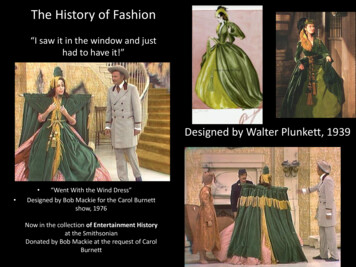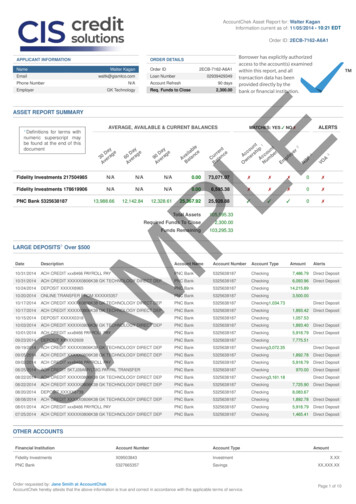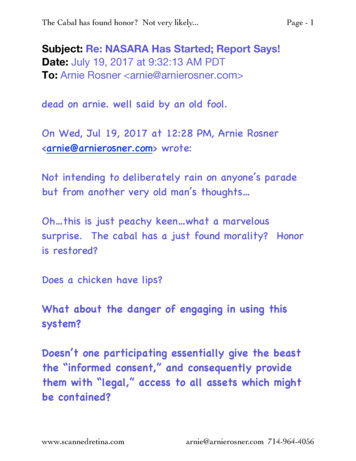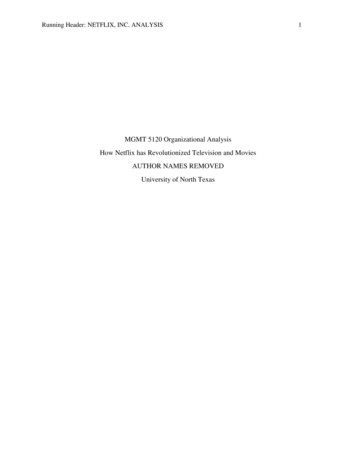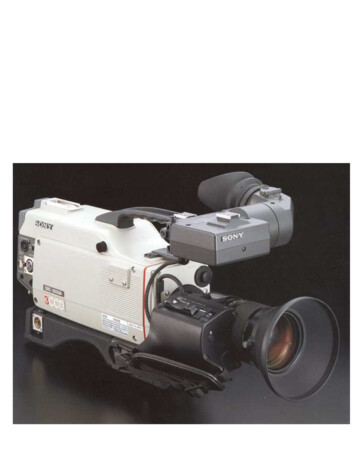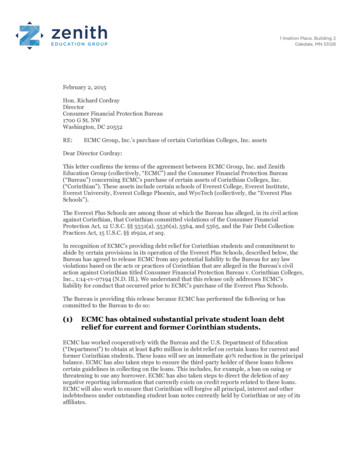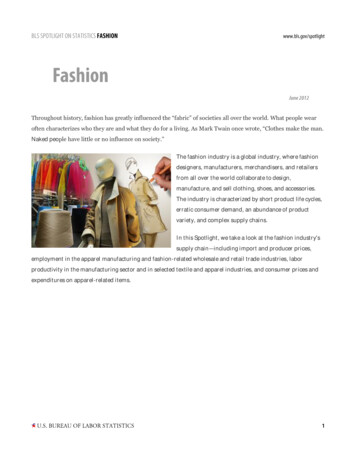
Transcription
Throughout history, fashion has greatly influenced the “fabric” of societies all over the world. What people wearoften characterizes who they are and what they do for a living. As Mark Twain once wrote, “Clothes make the man.Naked people have little or no influence on society.”The fashion industry is a global industry, where fashiondesigners, manufacturers, merchandisers, and retailersfrom all over the world collaborate to design,manufacture, and sell clothing, shoes, and accessories.The industry is characterized by short product life cycles,erratic consumer demand, an abundance of productvariety, and complex supply chains.In this Spotlight, we take a look at the fashion industry'ssupply chain—including import and producer prices,employment in the apparel manufacturing and fashion-related wholesale and retail trade industries, laborproductivity in the manufacturing sector and in selected textile and apparel industries, and consumer prices andexpenditures on apparel-related items.
In 2010, households spent, on average, 1,700 (nominal dollars) on apparel, footwear,and related products and services—3.5 percent of average annual expenditures. Since1985, as a percentage of total apparel expenditures, households spent more, onaverage, on apparel designed for women aged 16 and over than any other apparelproduct or service.(This is an interactive chart on the BLS Spotlight HTML page.)Source: Consumer Expenditure Survey
Employment in the apparel manufacturing industry has declined by more than 80percent (from about 900,000 to 150,000 jobs) over the past two decades. The declinehas been proportional throughout the apparel manufacturing component industries.(This is an interactive chart on the BLS Spotlight HTML page.)Source: Current Employment Statistics
The apparel manufacturing industry includes a diverse range of establishmentsmanufacturing full lines of ready-to-wear and custom apparel; apparel contractors,performing cutting or sewing operations on materials owned by others; and tailors,manufacturing custom garments for individual clients. Knitting, when done alone, isclassified in the textile mills subsector, but when knitting is combined with theproduction of complete garments, the activity is classified in the apparelmanufacturing industry.In 2010, there were 7,855 private business establishments in the apparelmanufacturing industry, employing 157,587 workers—compared with 15,478establishments and 426,027 workers in 2001. In 2010, only two U.S. counties hadmore than 500 business establishments—Los Angeles county, California (2,509) andNew York county, New York (803).Source: Quarterly Census of Employment and Wages
The average size of establishments (the number of employees at a typical workplacesuch as a factory or store) has declined in most apparel manufacturing industries inrecent years, while it generally remained little changed in fashion-related retail tradeindustries.In apparel manufacturing, the average number of employees per establishmentdeclined from 28 to 20 over the 2001–2010 period, though it stayed about the same inwomen's and girls' cut and sew apparel manufacturing.Source: Quarterly Census of Employment and Wages
The average number of employees per establishment in clothing stores stayed near 13during the 2001–2010 period, though it decreased from 25 to 21 in family clothingstores.Source: Quarterly Census of Employment and Wages
From 1990 to 2011, within the wholesale trade industry, employment in industriessuch as jewelry and women's and children's clothing experienced little or no change.However, over that period, employment in the men's and boy's clothing industrydecreased 17.5 percent—from 32,000 jobs in 1990 to 26,400 jobs in 2011.Within the retail trade industry, employment in men's and women's clothing stores,shoe stores, and jewelry, luggage, and leather goods stores decreased from 1990 to2011. In contrast, industries such as children's and infant's clothing (118.6 percent),cosmetic and beauty supply stores (82.3 percent), family clothing (63.2 percent), andclothing accessories stores (57.0 percent) all experienced an increase in employmentfrom 1990 to 2011. From 1990 to 2007, employment in family clothing storesincreased from 273,700 jobs to 539,800 jobs, or 97.2 percent. Since 2007, the familyclothing stores industry has lost 93,100 jobs, or 17.2 percent.(This is an interactive chart on the BLS Spotlight HTML page.)
Source: Current Employment Statistics
In 2010, earnings in many occupations associated with apparel manufacturing weretypically lower than the average for all occupations ( 45,230). Among theseoccupations, fabric and apparel patternmakers—who use computer-aided design(CAD) software to determine the best layout of pattern pieces to minimize waste ofmaterial and to create a master pattern for each size within a range of garmentsizes—earned an annual mean wage of 44,650. There were a total of 6,410 fabric andapparel patternmakers employed in 2010. Occupations such as textile and garmentpressers, sewing machine operators, hand sewers, shoe and leather workers andrepairers, and textile bleaching and dyeing machine operators and tenders earned amean annual wage that was more than 15,000 below the average for all occupations.In 2010, sewing machine operators, with 142,860 workers, was the largest of theseoccupations.Fashion designers earned an annual mean wage of 73,930 in 2010, over 25,000more than the average for all occupations. There were a total of 16,010 fashiondesigners employed in 2010.(This is an interactive chart on the BLS Spotlight HTML page.)
Source: Occupational Employment Statistics
Fashion designers create original or exclusive custom-fitted clothing (e.g. hautecouture), accessories, and footwear. In doing so, they must know how to sketchdesigns, select fabrics and patterns, and give instructions on how to make theproducts they design. Fashion designers work in wholesale or manufacturingestablishments, apparel companies, retailers, theater or dance companies, and designfirms.Within the United States, most fashion designers work in large cities, such as NewYork or Los Angeles. In May 2010, almost 75 percent of all salaried fashion designersworked in New York and California. California led the nation, with a total of 4,480employed fashion designers.NOTE: For more information, visit the occupational profile on fashion designers.(This is an interactive chart on the BLS Spotlight HTML page.)Source: Occupational Employment Statistics
Across the country, the mean annual wage earned by fashion designers ranged from 44,100 for those employed in Virginia to 80,650 for those employed in Maine andNew York.NOTE: For more information, visit the occupational profile on fashion designers.(This is an interactive chart on the BLS Spotlight HTML page.)Source: Occupational Employment Statistics
Among all states, California had the highest concentration of fashion designers. Ingeneral, location quotients are ratios that compare the concentration of a resource oractivity, such as employment, in a defined area to that of a larger area or base. Forexample, location quotients can be used to compare State employment by occupationto that of the nation. For more information on location quotients, visit our tutorial.NOTE: For more information, visit the occupational profile on fashion designers.(This is an interactive chart on the BLS Spotlight HTML page.)Source: Occupational Employment Statistics
Over the 2010–2020 period, as clothing continues to be made in other countries andthe demand for custom clothing keeps declining, occupations such as sewing machineoperators, fabric and apparel patternmakers, textile and garment pressers, and textileknitting and weaving machine setters, operators, and tenders are all projected todecrease in employment. Among those occupations, the number of sewing machineoperators is expected to decline by 25.8%, or 42,100 jobs.Employment in skilled occupations such as fashion designers and tailors,dressmakers, and custom sewers are projected to experience limited growth over the2010–2020 period. Tailors, dressmakers, and custom sewers are projected to increaseby 2.0 percent, or 900 workers, while fashion designers are projected to experiencelittle or no change.(This is an interactive chart on the BLS Spotlight HTML page.)
Source: Employment Projections Program
From 1996 to 2011, the U.S. apparel manufacturing industry experienced many joblosses—averaging 323 mass layoff events per year. During that period, the largestnumber of mass layoff events occurred in 1996, when the apparel manufacturingindustry initiated a total of 706—leading to the filing of 67,511 initial claims forunemployment insurance benefits.From 1996 to 2011, textile mills averaged a total of 200 mass layoff events per year,while leather and allied product manufacturers averaged 54 events per year. In 1996,apparel, textile mill, and leather and allied product manufacturers initiated a total of1,040 mass layoff events—representing 7.1 percent of all mass layoff events innonfarm establishments.A mass layoff event occurs when fifty or more initial claims for unemploymentinsurance benefits are filed against an employer during a 5-week period, regardless ofthe duration of the layoff.Source: Mass Layoff Statistics
A comparison of fashion-related industries shows that the rate of injuries variedamong industries in 2010. Employees in thread mills had a higher than average injuryrate of 6.7 per 100 full-time workers, whereas employees in yarn texturizing,throwing, and twisting thread mills suffered fewer injuries and illnesses at 1.8percent.In apparel manufacturing, the injury and illness rates in glove and mittenmanufacturing, at 8.8 percent, was the highest of all measured occupations related tothe fashion industry. Men’s footwear (except athletic) manufacturing had a rate of 7.6percent, compared with other footwear manufacturing at 3.6 percent.(This is an interactive chart on the BLS Spotlight HTML page.)Source: Injuries, Illnesses, and Fatalities
Productivity, a key measure of efficiency, is the amount of output produced per hourof work. Labor productivity in the U.S. manufacturing sector more than doubled from1987 to 2010. Labor productivity also more than doubled over that period in U.S.textile mills and nearly doubled in footwear manufacturing. Labor productivity inapparel manufacturing followed a different pattern; it grew at about the same rate asoverall manufacturing productivity from 1987 to 2000 but generally declined from2000 to 2010.Source: Labor Productivity and Costs
U.S. manufacturing output was nearly 50 percent higher in 2010 than in 1987 afteradjusting for inflation, but real output in U.S. textile, apparel, and footwearmanufacturing, declined substantially over the 1987–2010 period.Source: Labor Productivity and Costs
The number of hours that U.S. manufacturing employees worked remained fairlysteady from 1987 to 2000 and then declined by about one-third between 2000 and2010. Hours worked in U.S. textile, apparel, and footwear manufacturing declinednearly continuously and much more sharply than overall manufacturing hours duringthe 1987–2010 period.Source: Labor Productivity and Costs
Unit labor costs describe the relationship between compensation and laborproductivity. Increases in hourly compensation increase unit labor costs; increases inlabor productivity lower unit labor costs. Unit labor costs in U.S. manufacturing haveheld fairly steady since the late 1980s, meaning that manufacturers generally havebeen able to offset increases in compensation costs with improved efficiency. Unitlabor costs for U.S. textile manufacturers also have held fairly steady since the late1980s, but unit labor costs in U.S. apparel and footwear manufacturing weresubstantially higher in 2010 than in 1987.Source: Labor Productivity and Costs
The Consumer Price Index for all items has risen at a much steeper rate than theindexes for apparel and shoes since 1978. Prices for apparel rose 62 percent from1978 to 1998, declined somewhat through 2005, and have been fairly steady in recentyears. Prices for footwear followed a similar pattern as apparel from 1978 to 2004,and footwear prices have increased somewhat more rapidly since 2004.Consumer prices for men’s and boys’ apparel rose at somewhat faster rate than pricesfor women’s and girls’ apparel from 1978 to 1998. Prices for both categories declinedsomewhat through 2007 before leveling off in recent years. Prices for men’s andwomen’s footwear followed similar patterns as prices for apparel.Consumer prices for infants’ and toddlers’ apparel rose about 69 percent from 1978to 2000 and have generally declined since then.(This is an interactive chart on the BLS Spotlight HTML page.)
Source: Consumer Price Index
When shopping for clothing, shoes, and accessories in retail stores or over theInternet, a consumer’s first thought about price is most likely not about the priceexchange that occurs before the item is available at the retail level, although thattransaction heavily influences the price the consumer sees. While producer prices forselected fashion-related industries have trended higher since December 2003, theProducer Price Index (PPI) for fabric mills, a major component in textile-relatedproduction, increased significantly from October 2010 until September 2011. Incomparison, producer price increases for other industries such as footwearmanufacturing and for accessories and other apparel were more muted untilDecember 2011, when their rates of increase started to accelerate.Source: Producer Price Index
Have you ever wondered about the journey your clothes, shoes, and accessoriestraveled before these items found a home in your closet? Chances are your wardrobeincludes many import components from across the globe. From December 2010 toFebruary 2011, import prices for fabric mill products increased sharply and havecontinued to increase. Import prices for apparel accessories and other apparelmanufacturing were higher than footwear manufacturing from September 2007 untilOctober 2011, when footwear prices overtook apparel accessories and other appareland have remained steady.Source: Import/Export Price Indexes
In 2007, among those countries studied by the Bureau of Labor Statistics, Germanyhad the highest hourly compensation costs within the apparel manufacturingindustry. The Philippines, with compensation costs at 88 cents per hour, had thelowest among those countries studied.From 2006 to 2007, with the exception of Taiwan and Japan, hourly compensationcosts increased in all countries studied—including the United States. From 2002 to2007, Argentina and Australia experienced the largest increase in hourlycompensation costs—increasing 154 percent. Over that period, Japan experienced thesmallest increase in hourly compensation costs—from 11.77 per hour to 12.70 perhour, or 8 percent. Compensation costs for the United States increased from 15.37per hour to 20.42 per hour, or 33 percent.(This is an interactive chart on the BLS Spotlight HTML page.)
Source: International Labor Comparisons
Note: Data in text, charts and tables are the latest available at the time of publication.Internet links may lead to more recent data.For more information, please call (202) 691-5200.The news media can contact the BLS Press Officer at(202) 691-5902.
Naked people have little or no influence on society.” The fashion industry is a global industry, where fashion designers, manufacturers, merchandisers, and retailers from all over the world collaborate to design, manufacture, and sell clothing, shoes, and accessories. Th

